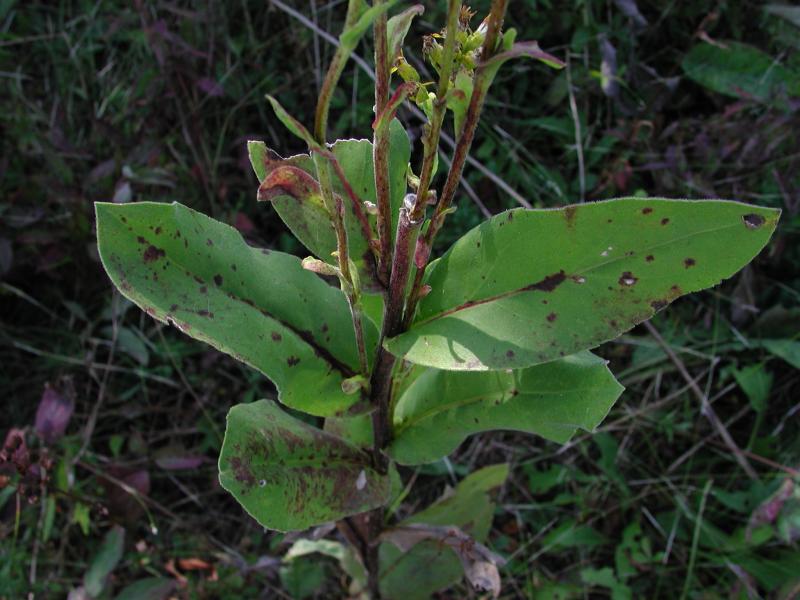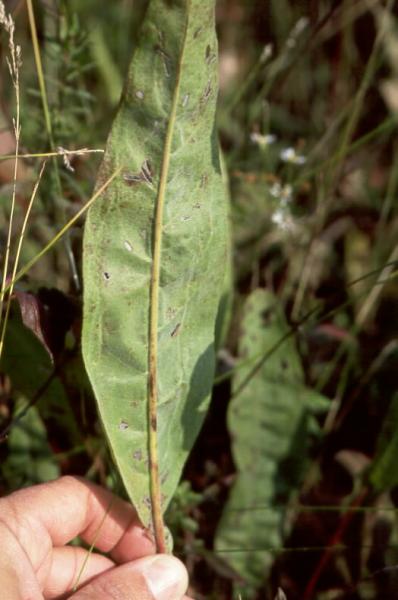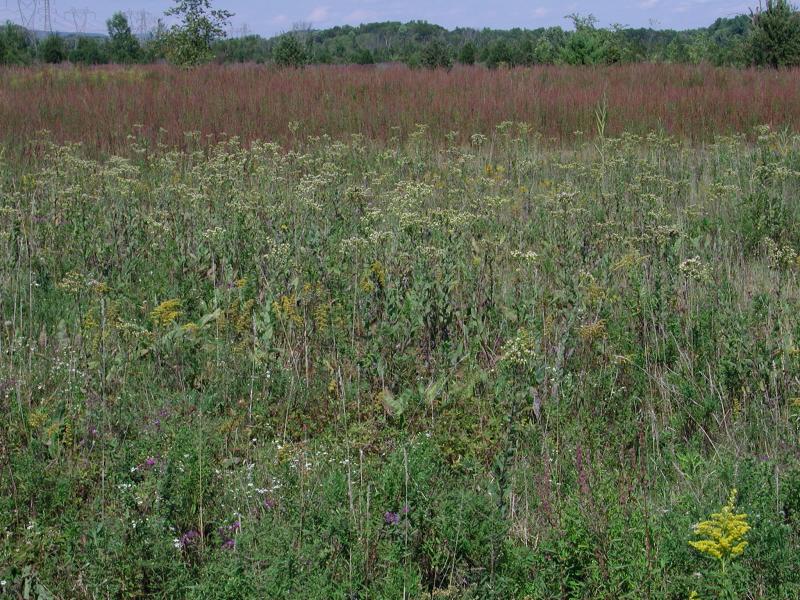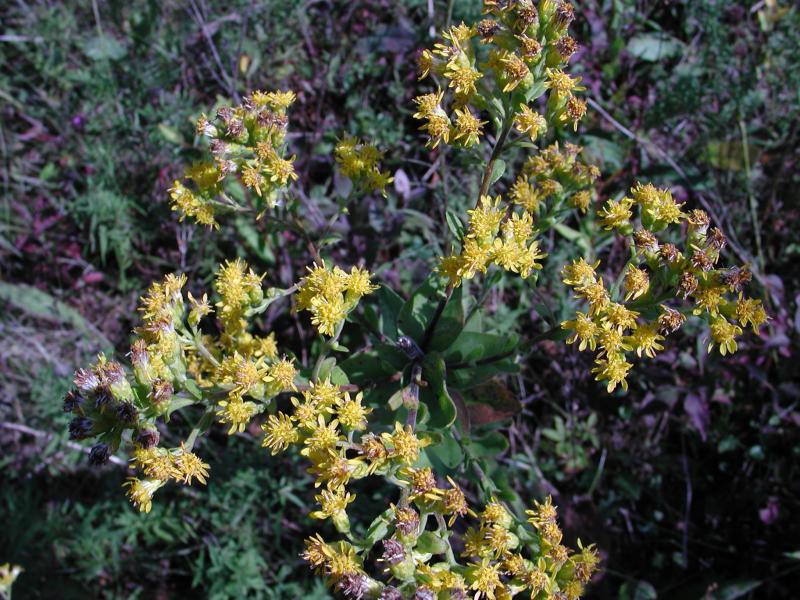Stiff Flat-topped Goldenrod
Solidago rigida var. rigida None
- Class
- Dicotyledoneae (Dicots)
- Family
- Asteraceae (Aster Family)
- State Protection
- Threatened
Listed as Threatened by New York State: likely to become Endangered in the foreseeable future. For animals, taking, importation, transportation, or possession is prohibited, except under license or permit. For plants, removal or damage without the consent of the landowner is prohibited.
- Federal Protection
- Not Listed
- State Conservation Status Rank
- S2
Imperiled in New York - Very vulnerable to disappearing from New York due to rarity or other factors; typically 6 to 20 populations or locations in New York, very few individuals, very restricted range, few remaining acres (or miles of stream), and/or steep declines.
- Global Conservation Status Rank
- G5T5
Secure globally - Both the species as a whole and the subspecies/variety are common in the world; widespread and abundant (but may be rare in some parts of its range).
Summary
Did you know?
The genus gets its name from the Latin solidus, "whole," referring to the reputed properties of the goldenrods to heal wounds. The specific name refers to its stiff leaves. Rare in the states along the east coast, this goldenrod is very common in the midwestern and prairie states where it blankets grasslands with its showy, flat-topped flower stalks.
State Ranking Justification
There are nine known populations and at least ten additional historical locations. This plant has been threatened by habitat conversion, mainly housing developments. Various invasive species have also had a negative impact.
Short-term Trends
There has been a short-term decrease in plant numbers because of development of some of the sites and other unknown causes. Some plants have been rescued at one site and transplanted to another area.
Long-term Trends
Long term numbers have stayed around ten populations with new discoveries offsetting the extirpation of historical records.
Conservation and Management
Threats
There have been development pressures on many of the sites. Residential development and highway construction have extirpated or fragmented some sites.
Conservation Strategies and Management Practices
This plant does very well in successional old fields and other grassland habitats. Should woody vegetation become established, the populations would likely begin to decline. This would support using a brush-hog to occassionally (i.e. once every 3-5 years) to clear the woody vegetation.
Research Needs
Research is necessary to determine which management practices are best at keeping populations healthy.
Habitat
Habitat
A goldenrod of open areas on dry shaley slopes or on limestone bedrock; open areas among shrubby thickets and edge of grasslands over shallow, dry, sandy and rocky soils on limestone; dry post-agricultural successional habitats, usually on alkaline soils; successional fields on clay soils; rocky summit grasslands on alkaline and circum-neutral soils; grassland habitats on dry, clayey, stony soils; woodland edges between calcareous woodlands and successional old fields; and dry shaly hillsides and slopes (New York Natural Heritage Program 2004). Prairies, dry fields and hillsides; may spread along roadsides and railroads (Voss 1996). Prairies and other dry, open places, especially in sandy soil (Gleason and Cronquist 1991). Dry or gravelly open woods, thickets and prairies (Fernald 1970).
Associated Ecological Communities
- Calcareous talus slope woodland
(guide)
An open or closed canopy community that occurs on talus slopes composed of calcareous bedrock such as limestone or dolomite. The soils are usually moist and loamy; there may be numerous rock outcrops.
- Limestone woodland*
(guide)
A woodland that occurs on shallow soils over limestone bedrock in non-alvar settings, and usually includes numerous rock outcrops. There are usually several codominant trees, although one species may become dominant in any one stand.
- Mowed roadside/pathway
A narrow strip of mowed vegetation along the side of a road, or a mowed pathway through taller vegetation (e.g., meadows, old fields, woodlands, forests), or along utility right-of-way corridors (e.g., power lines, telephone lines, gas pipelines). The vegetation in these mowed strips and paths may be dominated by grasses, sedges, and rushes; or it may be dominated by forbs, vines, and low shrubs that can tolerate infrequent mowing.
- Red cedar rocky summit*
(guide)
A community that occurs on warm, dry, rocky ridgetops and summits where the bedrock is calcareous (such as limestone or dolomite, but also marble, amphibolite, and calcsilicate rock), and the soils are more or less calcareous. The vegetation may be sparse or patchy, with numerous lichen covered rock outcrops.
- Rocky summit grassland
(guide)
A grassland community that occurs on rocky summits and exposed rocky slopes of hills. Woody plants are sparse and may be scattered near the margin of the community. Small trees and shrubs may be present at low percent cover.
- Shale cliff and talus community*
(guide)
A community that occurs on nearly vertical exposures of shale bedrock and includes ledges and small areas of talus. Talus areas are composed of small fragments that are unstable and steeply sloping; the unstable nature of the shale results in uneven slopes and many rock crevices.
- Successional old field
A meadow dominated by forbs and grasses that occurs on sites that have been cleared and plowed (for farming or development), and then abandoned or only occasionally mowed.
- Successional shrubland*
A shrubland that occurs on sites that have been cleared (for farming, logging, development, etc.) or otherwise disturbed. This community has at least 50% cover of shrubs.
* probable association but not confirmed.
Associated Species
- Asclepias tuberosa (butterfly-weed)
- Aster dumosus
- Aster sagittifolius
- Carex argyrantha (silvery-green sedge)
- Carex brevior (short-beaked sedge)
- Carya cordiformis (bitternut hickory)
- Cornus foemina ssp. Racemosa
- Euthamia graminifolia (common flat-topped-goldenrod)
- Fraxinus americana (white ash)
- Lespedeza violacea (wand-like bush-clover)
- Ostrya virginiana (hop hornbeam, ironwood)
- Parthenocissus quinquefolia (Virginia-creeper)
- Penstemon digitalis (fox-glove beard-tongue)
- Pycnanthemum tenuifolium (narrow-leaved mountain-mint)
- Quercus macrocarpa (bur oak)
- Quercus palustris (pin oak)
- Quercus rubra (northern red oak)
- Rhus typhina (stag-horn sumac)
- Rudbeckia hirta (common black-eyed Susan)
- Schizachyrium scoparium
- Solidago canadensis
- Solidago juncea (early goldenrod)
- Solidago rugosa
- Sorghastrum nutans (Indian grass)
- Staphylea trifolia (bladdernut)
- Tilia americana var. americana (American basswood)
- Ulmus americana (American elm)
- Zanthoxylum americanum (prickly-ash)
Range
New York State Distribution
This goldenroad has a bimodal distribution, that includes the Niagara Escarpment and calcareous or circumneutral areas within the Hudson Valley. New York is at the northeastern edge of its range.
Global Distribution
This goldenrod ranges from Rhode Island, Connecticut, western Massachusetts, and New York, south to Georgia, and west to Minnesota and Missouri.
Identification Comments
General Description
This is a tall, stiffly erect goldenrod, with a thick, fuzzy stem. It usually grows about 1 to 1.5 meters tall with many thick, coarse, fuzzy, gray-green, stiff leaves along the stem. The margins of the leaves have few or no teeth. The lower leaves are long and lance-shaped with long leaf stalks, while the upper leaves are progressively shorter, upright, and clasp the stem. The bright yellow flower clusters at the top of the stem are more or less flat-topped.
Identifying Characteristics
A goldenrod with a coarse, puberulent, stem that is 25-150 cm tall. The herbage is densely pubescent with short spreading hairs. The leaves are numerous, thick and harsh, with a grayish-pubescent, and subentire or with appressed rounded teeth. The middle and upper leaves are sessile or nearly so, less than 3 times as long as broad, and much shorter than basal and lower leaves. These leaves are pubescent on both sides. The lower leaves are long-petioled with oval or oblong blades and 3-10 cm. broad. The flowering heads are flat topped and 8-25 cm broad. The involucres are 6-8 mm high.
Best Life Stage for Proper Identification
This goldenrod may be identified from basal leaves or any vegetative portion of the plant. The best life stage for identification, though, is while the plants are flowering.
Similar Species
A unique goldenrod that is easily distinguished from other goldenrods. The key characters of stiff-leaf goldenrod (Solidago rigida) are the flat-topped inflorescence, with stiff leaves that are hairy and ovate to elliptical (less than 3 times as long as broad).
Best Time to See
This goldenrod flowers between mid-August until early October with fruiting stalks persisting into late fall. While this plant can be identified vegetatively, it is easier to find when in flower. Surveys should be conducted in late summer to early fall.
- Vegetative
- Flowering
- Fruiting
The time of year you would expect to find Stiff Flat-topped Goldenrod vegetative, flowering, and fruiting in New York.
Stiff Flat-topped Goldenrod Images
Taxonomy
Stiff Flat-topped Goldenrod
Solidago rigida var. rigida None
- Kingdom Plantae
- Phylum Anthophyta
- Class Dicotyledoneae
(Dicots)
- Order Asterales
- Family Asteraceae (Aster Family)
- Order Asterales
- Class Dicotyledoneae
(Dicots)
- Phylum Anthophyta
Additional Common Names
- Hard-leaved Goldenrod
- Rigid Goldenrod
- Stiff Goldenrod
- Stiff-leaf Goldenrod
Synonyms
- Oligoneuron rigidum var. rigidum
- Solidago rigida L.
Additional Resources
Best Identification Reference
Gleason, Henry A. and A. Cronquist. 1991. Manual of Vascular Plants of Northeastern United States and Adjacent Canada. The New York Botanical Garden, Bronx, New York. 910 pp.
Other References
Fernald, M.L. 1950. Gray's manual of botany. 8th edition. D. Van Nostrand, New York. 1632 pp.
Holmgren, Noel. 1998. The Illustrated Companion to Gleason and Cronquist's Manual. Illustrations of the Vascular Plants of Northeastern United States and Adjacent Canada. The New York Botanical Garden, Bronx, New York.
Mitchell, Richard S. and Gordon C. Tucker. 1997. Revised Checklist of New York State Plants. Contributions to a Flora of New York State. Checklist IV. Bulletin No. 490. New York State Museum. Albany, NY. 400 pp.
New York Natural Heritage Program. 2010. Biotics database. New York Natural Heritage Program. New York State Department of Environmental Conservation. Albany, NY.
New York Natural Heritage Program. 2024. New York Natural Heritage Program Databases. Albany, NY.
Reschke, Carol. 1990. Ecological communities of New York State. New York Natural Heritage Program, New York State Department of Environmental Conservation. Latham, NY. 96 pp. plus xi.
Voss, Edward G. 1996. Michigan Flora Part III. Dicots Concluded (Pyrolaceae - Compositae). Cranbrook Institute of Science Bulletin 61 and University of Michigan Herbarium. 622 pp.
Weldy, T. and D. Werier. 2010. New York flora atlas. [S.M. Landry, K.N. Campbell, and L.D. Mabe (original application development), Florida Center for Community Design and Research http://www.fccdr.usf.edu/. University of South Florida http://www.usf.edu/]. New York Flora Association http://newyork.plantatlas.usf.edu/, Albany, New York
Links
About This Guide
Information for this guide was last updated on: December 22, 2004
Please cite this page as:
New York Natural Heritage Program. 2024.
Online Conservation Guide for
Solidago rigida var. rigida.
Available from: https://guides.nynhp.org/stiff-flat-topped-goldenrod/.
Accessed July 27, 2024.






